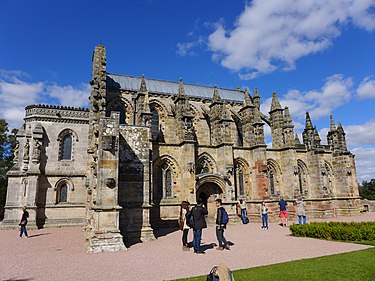Ian Gardner, Director of Rosslyn Chapel Trust, delivered a comprehensive and very enjoyable talk on this remarkable chapel. Conceived as a family chapel by Sir William St Clair (Sinclair) in the mid 15th century, the building was founded in 1446 and construction continued for about 40 years. By 1484, at the time of Sir William’s death, the structure was essentially as we see it today. It is incomplete! Sir William’s intention seems to have been to extend the chapel westwards, creating a nave and transepts, but his death brought work to a halt. His descendants lacked either the funds or the will to complete it. The west wall clearly was never intended to be an outer wall, having features which identify it as internal in structure. During the Reformation the alter was destroyed and the the chapel fell into disuse. In the 17th century, Cromwell sacked Rosslyn castle nearby, but spared the chapel, using it as stabling for his horses. Stained glass windows were first introduced in the 18th century and the chapel was visited and commented upon by Dorothy Wordsworth and Robert Burns. Walter Scott, however,through his popularity as a novelist and poet,raised the profile of the chapel nationally when he included it in ‘The Lay of the Last Minstrel’. Visitors here increased as a result, reflecting Scott’s reputation as the founder of the Scottish tourist industry. A visit by Queen Victoria in 1842 amply reinforced Scott’s earlier influence. The chapel was then re-dedicated in 1862 as a place of worship and has served ever since as an Episcopalian church.
Built of local sandstone, including the roof, the chapel gradually began to show signs of wear and tear mainly due to the ingress of water through the porous stone. Serious conservation efforts were undertaken in the 1950s by the Ministry of Works, involving sealing the inside surfaces with a thin layer of cement. However, although this was considered best practice at the time, it could not prevent further deterioration. Trapped moisture encouraged the growth of green algae in the roof and led to further deterioration. Thus in 1997 the Rosslyn Chapel Trust began an extended programme of work to protect and restore the building. A large open canopy was constructed to cover the chapel and to allow the stonework to dry out slowly and naturally. Work continued to repoint the stonework and to renovate and restore some of the intricate carvings inside, assisted by a large Heritage Lottery Fund Grant. In the mid 2000s Dan Brown published The Da Vinci Code, featuring Rosslyn Chapel, and a film followed. As a result, visitor numbers climbed from a few thousand per year to over 150,000! The restoration project, with a modern and well conceived Visitor Centre was completed in 2012.
Community involvement in the project has been very significant. For example, the local primary school each year provides pupils willing to train up (and dress up in suitable medieval costume) to act as guides for tourists. This has been an extremely successful and popular development which the children obviously enjoy.
The development of the nearby Castle, and of an old Inn next to the chapel,for self catering holiday accommodation provides a steady income for the Trust and so will continue to fund maintenance work for the foreseeable future.
Ian’s comprehensive exposition then took us on a visual and verbal trip around the internal structures and carvings, including the famous ‘Apprentice Column’ and the stories/myths associated with this and with the chapel as a whole.
I conclude by commending the Rosslyn Chapel website as an excellent source of detailed information well worth looking up.
Peter R
